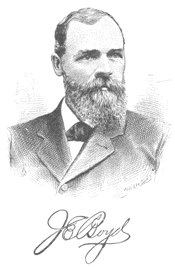Lynch Site - The Lynch Site was a large village of circular earthlodges occupied about A.D. 1450-1550. Few villages from this period were located in Nebraska, the majority having been established along the Missouri River in South Dakota. Lynch, and villages like it, reflect a prehistoric blending of cultures from central Nebraska and the Missouri River valley in the Dakotas from which the historic Pawnee and Arikara tribes emerged several centuries later.
White Horse Ranch - The White Horse Ranch was founded in 1936 by Cal and Ruth Thompson. The ranch covers approximately 2,400 acres along the Niobrara River in Boyd County. It is historically significant as the place of origin of a registered breed of horse, the American Albino or American White. This is apparently the only breed of livestock developed exclusively in Nebraska.
Ponca Creek Bridge - Flowing west to east across nearly the entire width of Boyd County, Ponca Creek formed a troublesome barrier to intercounty traffic. As a result, most of the county's bridge budget historically has been directed toward erecting and maintaining Ponca Creek spans. Constructed in 1904 this forty-eight-foot pony truss, located near Lynch, is the only one of the earliest Ponca Creek bridges in the county that remains in its original location. The remainder have either been moved or replaced. As the oldest vehicular bridge in the county, and the most significant extant Ponca Creek span, this bridge enjoys a degree of historical significance.
S.S. Peter and Paul Catholic School - Built in 1909, the S.S. Peter and Paul Catholic School, located in Butte, is a typical example of the multi-story, brick, "fireproof" parochial school buildings that were constructed in virtually every Catholic community in Nebraska during the first quarter of the twentieth century. These schools were, and are, a symbol of community permanence and progressive interest in parochial education. The building features all the characteristics of a period school: chapel, boarding rooms for the students, and nuns quarters. The school is significantly associated with parochial education in Boyd County, as it was the only Catholic elementary school built in the county.
Lewis & Clark Campsite - Located U.S. 281, 4.6 miles north of Spencer.
"...The journal entry of the Lewis and Clark expedition for September 7, 1804, in what is now Boyd County, Nebraska, reported that almost the entire Corps of Discovery spent much of that day carrying kettles, pots and pails of Missouri River water up the bank to flood some burrows. Before nightfall, the exhausted bucket brigade finally succeeded in catching one live but bedraggled prairie dog. The next spring, the expedition shipped the animal in a cage back East to President Thomas Jefferson. "


